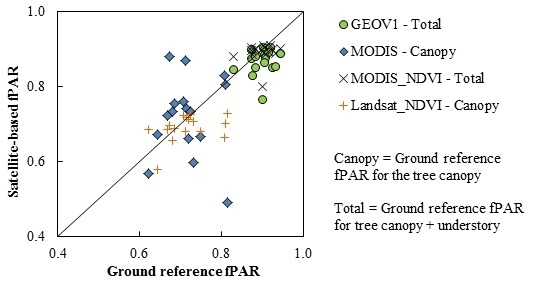Validation of MODIS and GEOV1 fPAR Products in a Boreal Forest Site in Finland
Abstract
:1. Introduction
2. Materials and Methods
2.1. Study Site
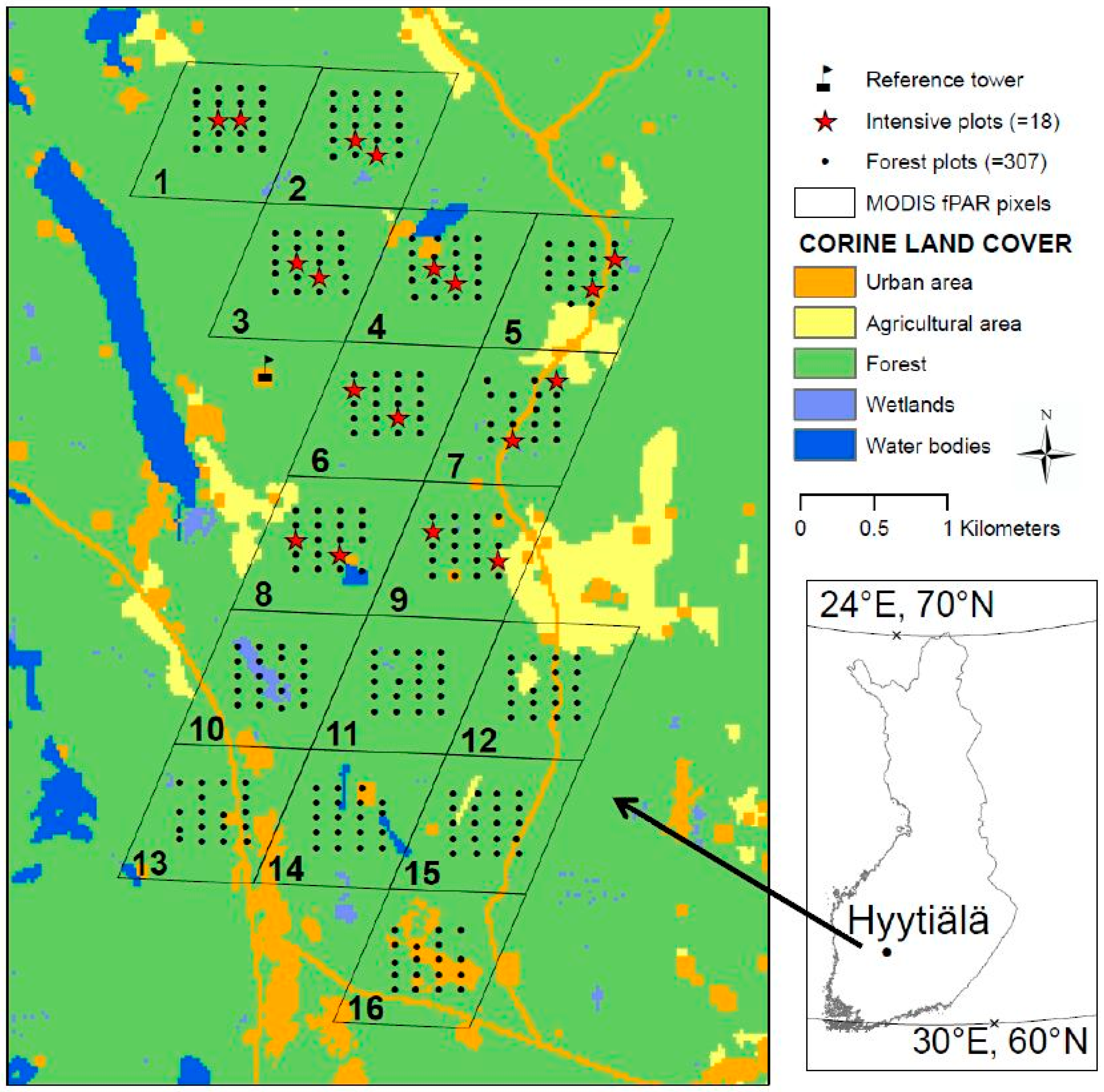
| Species | N | ba | h | LAI | |||
|---|---|---|---|---|---|---|---|
| Range | Mean | Range | Mean | Range | Mean | ||
| Pine | 124 | 0–36.0 | 14.0 | 1.4–28.6 | 17.0 | 0.3–3.9 | 1.9 |
| Pine (intensive) | 8 | 3.8–22.0 | 16.2 | 4.5–20.8 | 15.8 | 0.9–2.9 | 2 |
| Spruce | 122 | 0–36.0 | 14.6 | 0.3–28.0 | 16.7 | 0.2–5.0 | 2.7 |
| Spruce(intensive) | 6 | 19.0–36.0 | 26.3 | 10.8–24.0 | 18.1 | 3.0–3.6 | 3.3 |
| Birch | 35 | 0–29.0 | 7.8 | 0.5–23.8 | 10.5 | 0.2–3.8 | 2.0 |
| Birch (intensive) | 3 | 1.8–15.0 | 9.3 | 4.9–16.0 | 10.6 | 0.7–2.0 | 1.5 |
| Mixed | 26 | 0–15.4 | 7.2 | 2.0–22.8 | 15.5 | 0.4–4.5 | 2.7 |
| Mixed (intensive) | 1 | - | 12.5 | - | 17.0 | - | 2.2 |
| Pixel ID | ba (m2/ha) | h (m) | LAIe | Pine% | Spruce% | Decid.% | GG% | Litter% | Ustory% |
|---|---|---|---|---|---|---|---|---|---|
| 1 | 12.6 | 13.8 | 2.9 | 17.1 | 74.7 | 8.3 | 39.9 | 60.1 | 20.8 |
| 2 | 10.8 | 16.5 | 2.1 | 50.0 | 44.7 | 5.2 | 45.0 | 50.0 | 37.8 |
| 3 | 20.7 | 20.7 | 2.7 | 34.5 | 61.6 | 3.9 | 64.3 | 35.8 | 29.1 |
| 4 | 10.7 | 14.2 | 2.3 | 21.7 | 42.7 | 35.7 | 18.8 | 81.3 | 38.1 |
| 5 | 9.6 | 13.4 | 2.2 | 68.3 | 19.1 | 12.6 | 35.4 | 64.6 | 31.7 |
| 6 | 16.3 | 16.9 | 2.8 | 15.1 | 62.2 | 22.7 | 37.6 | 62.4 | 35.6 |
| 7 | 11.3 | 13.5 | 2.3 | 18.8 | 45.5 | 35.7 | 44.4 | 55.3 | 38.2 |
| 8 | 13.5 | 13.6 | 2.3 | 28.9 | 49.8 | 21.4 | 40.0 | 60.0 | 47.0 |
| 9 | 9.6 | 16.7 | 2.4 | 28.3 | 36.9 | 34.8 | 34.3 | 65.7 | 38.0 |
| 10 | 14.1 | 15.0 | 2.1 | 55.4 | 23.9 | 20.7 | 60.1 | 39.9 | 28.6 |
| 11 | 12.8 | 16.3 | 2.5 | 17.3 | 71.5 | 11.3 | 46.4 | 53.6 | 37.1 |
| 12 | 13.0 | 21.0 | 2.2 | 48.7 | 43.4 | 7.8 | 60.7 | 39.3 | 33.2 |
| 13 | 10.0 | 12.8 | 2.0 | 37.4 | 39.6 | 23.0 | 37.4 | 59.6 | 27.2 |
| 14 | 9.6 | 15.0 | 2.0 | 36.2 | 42.4 | 21.5 | 47.4 | 52.6 | 32.6 |
| 15 | 16.0 | 19.8 | 1.9 | 82.8 | 10.3 | 6.8 | 72.0 | 28.0 | 34.6 |
| 16 | 15.2 | 16.0 | 1.7 | 84.8 | 1.3 | 13.9 | 62.6 | 32.9 | 26.9 |
2.2. Field Measurements of Canopy Transmittance
2.2.1. LAI-2000 Measurements
2.2.2. TRAC Measurements
2.3. Calculation of Ground Reference fPAR
2.3.1. fPAR from LAI-2000 Data
2.3.2. fPAR from TRAC
2.4. Satellite-Based fPAR
| Product details | MODIS | GEOV1 |
|---|---|---|
| fPAR definition: | Green vegetation fPAR, | Green vegetation fPAR, |
| instantaneous black-sky 10:30 AM | instantaneous black-sky ~10:15 AM | |
| Sensor: | MODIS Terra | SPOT VEGETATION |
| Algorithm: | Inversion of 3D radiative transfer model | Trained neural networks |
| Input: | Top-of-canopy reflectance | Top-of-canopy reflectance |
| Prior data: | Landcover map (MCD12) | Fused and scaled CYCLOPES & MODIS |
| Parameterization: | 8 biomes | Global |
| Spatial resolution: | 1 km | 1 km |
| Temporal resolution: | 8 days | 10 days |
| Composition period: | 8 days | 30 days |
| Statistical method: | Maximum | 70 percentile |
| Reference: | Myneni et al. [34] | Baret et al. [35] |
| Data provider: | NASA/Boston university | Geoland2 |
2.4.1. MODIS and GEOV1 fPAR Products
2.4.2. NDVI Based fPAR Estimation
| Abbreviation | Definition | Reference |
|---|---|---|
| Ground-based: | ||
| fPARTRAC | Measured ground-based fPAR using TRAC | Leblanc et al. [25] |
| fPARCANOPY | Modeled ground reference fPAR for the tree canopy | Stenberg et al. [19], Majasalmi et al. [20] |
| fPARUSTORY | Modeled ground reference fPAR for the green understory and ground layer | Picket-Heaps et al. [6] |
| fPARTOTAL | Ground reference fPAR (fPARCANOPY + fPARUSTORY) | |
| Satellite-based: | ||
| fPARMODIS | MODIS LAI/fPAR product (MOD15A2) | Knyazikhin et al. [33], Myneni et al. [34] |
| fPARGEOV1 | GEOV1 fPAR product (BioPar FAPAR) | Baret et al. [35] |
| fPARMOD09GQ | fPAR calculated using MODIS surface reflectance product (MOD09GQ) and NDVI-fPAR relationship | Knyazikhin et al. [33] |
| fPARLANDSAT | fPAR calculated using Landsat 8 image and NDVI-fPAR relationship | Knyazikhin et al. [33] |
3. Results
3.1. Comparison of Ground-Based Methods for fPAR
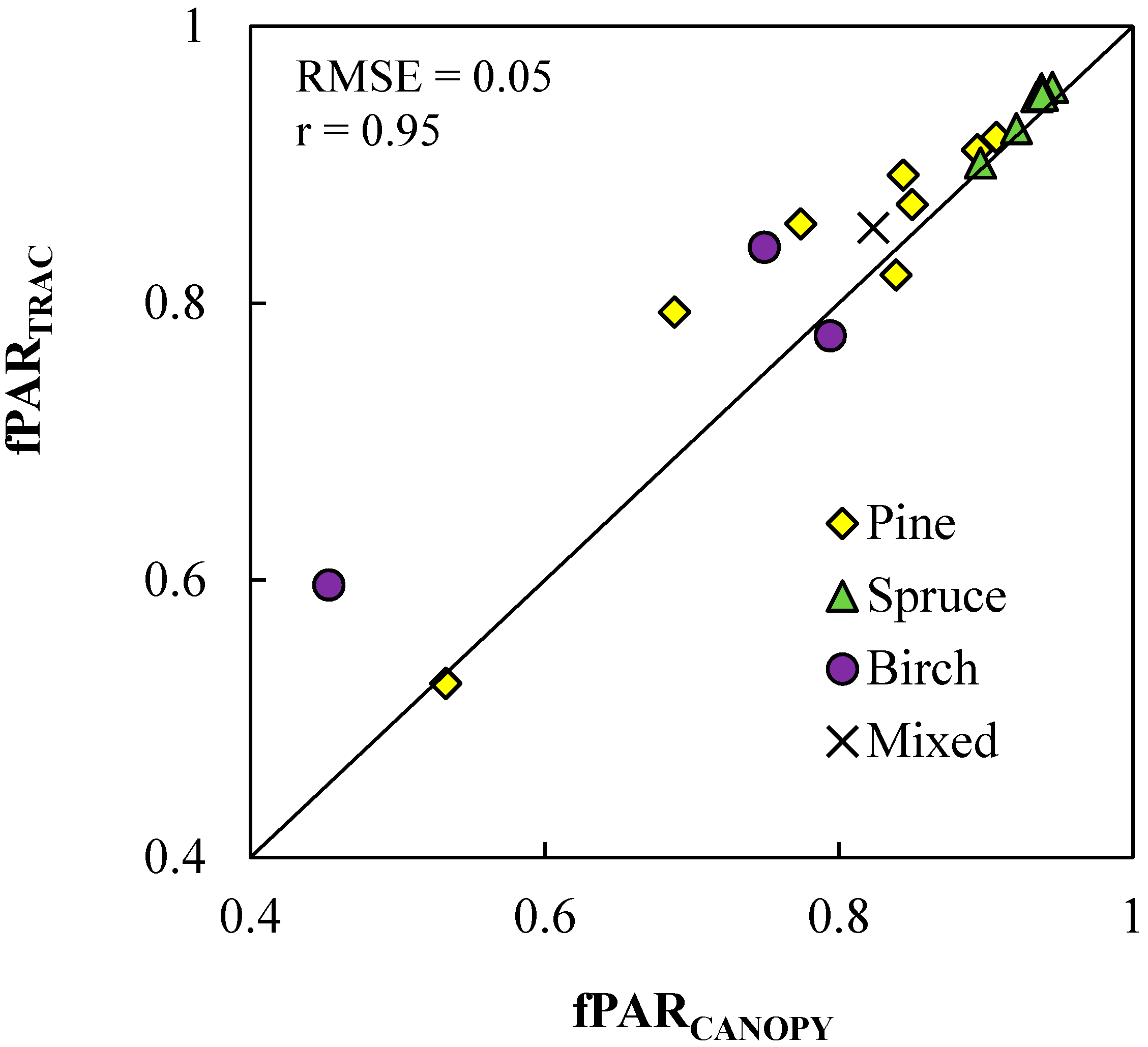
3.2. Quality Analysis of Satellite-Based fPAR Products
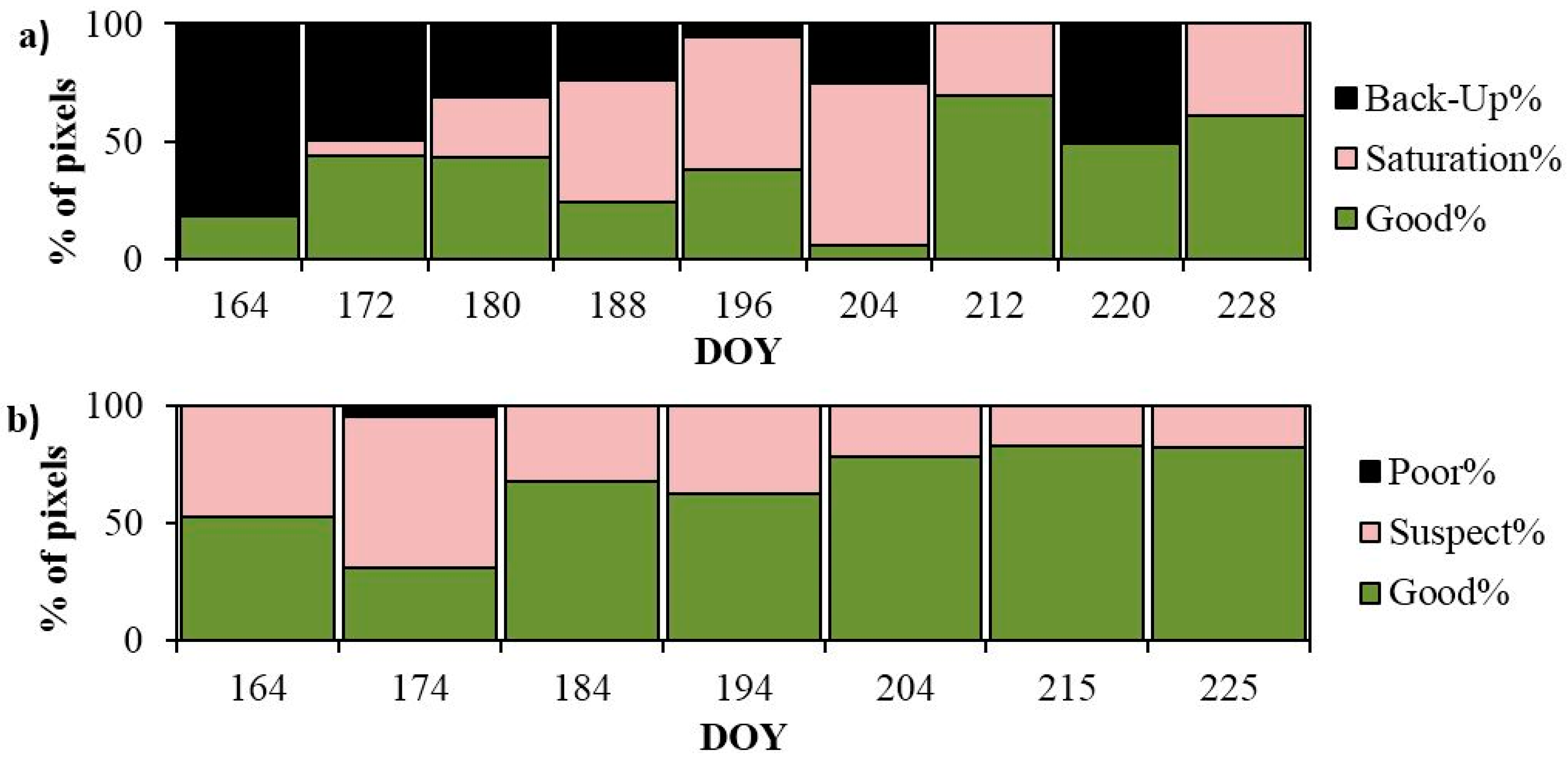
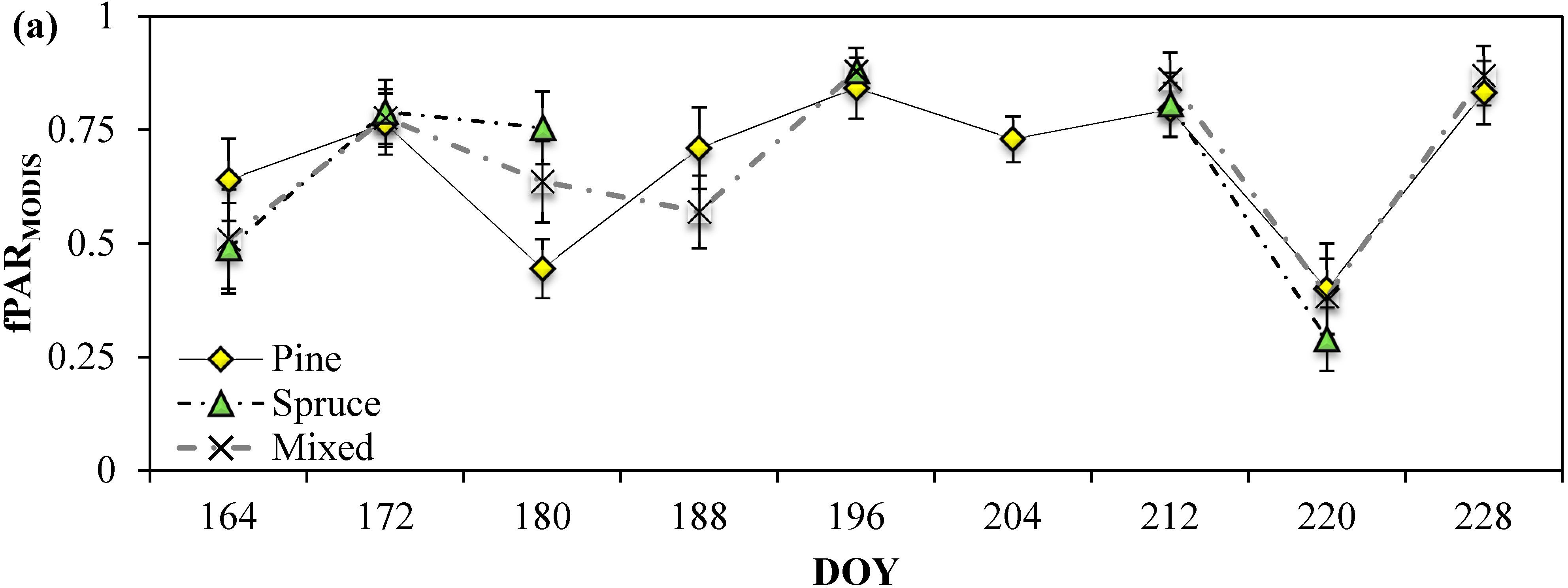
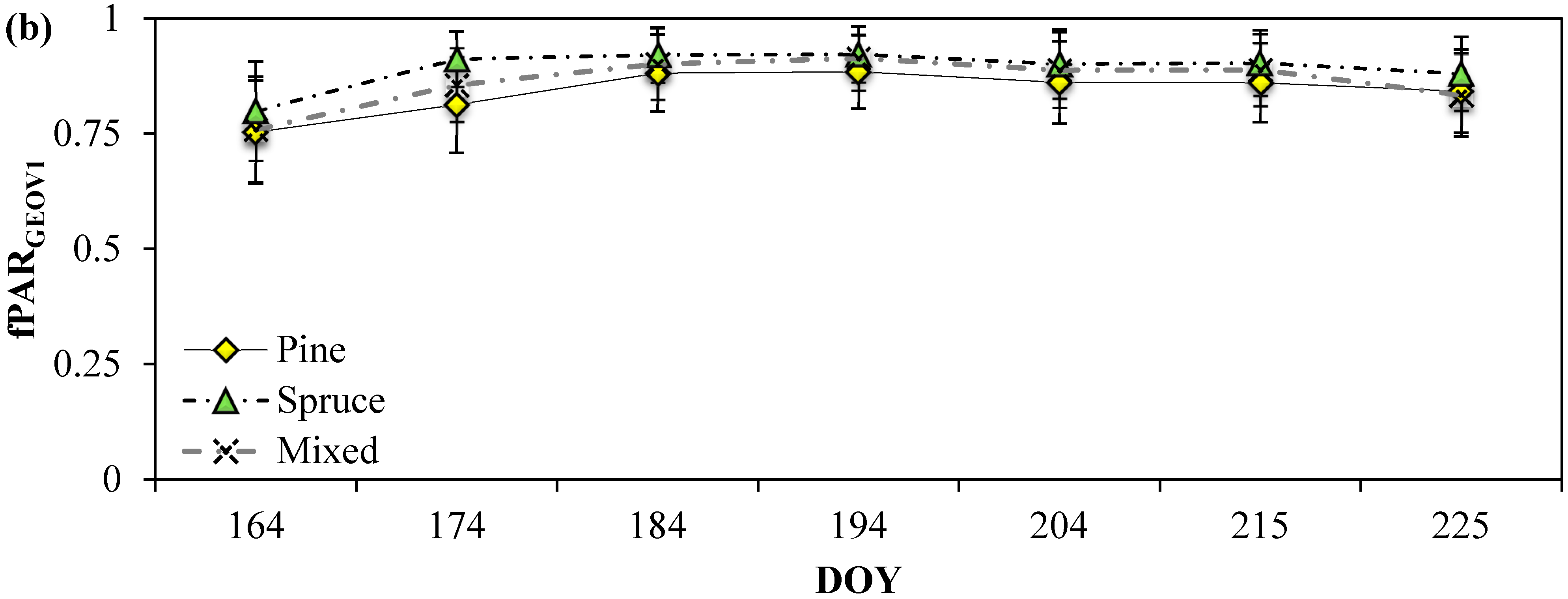
3.3. Validation of fPAR Products
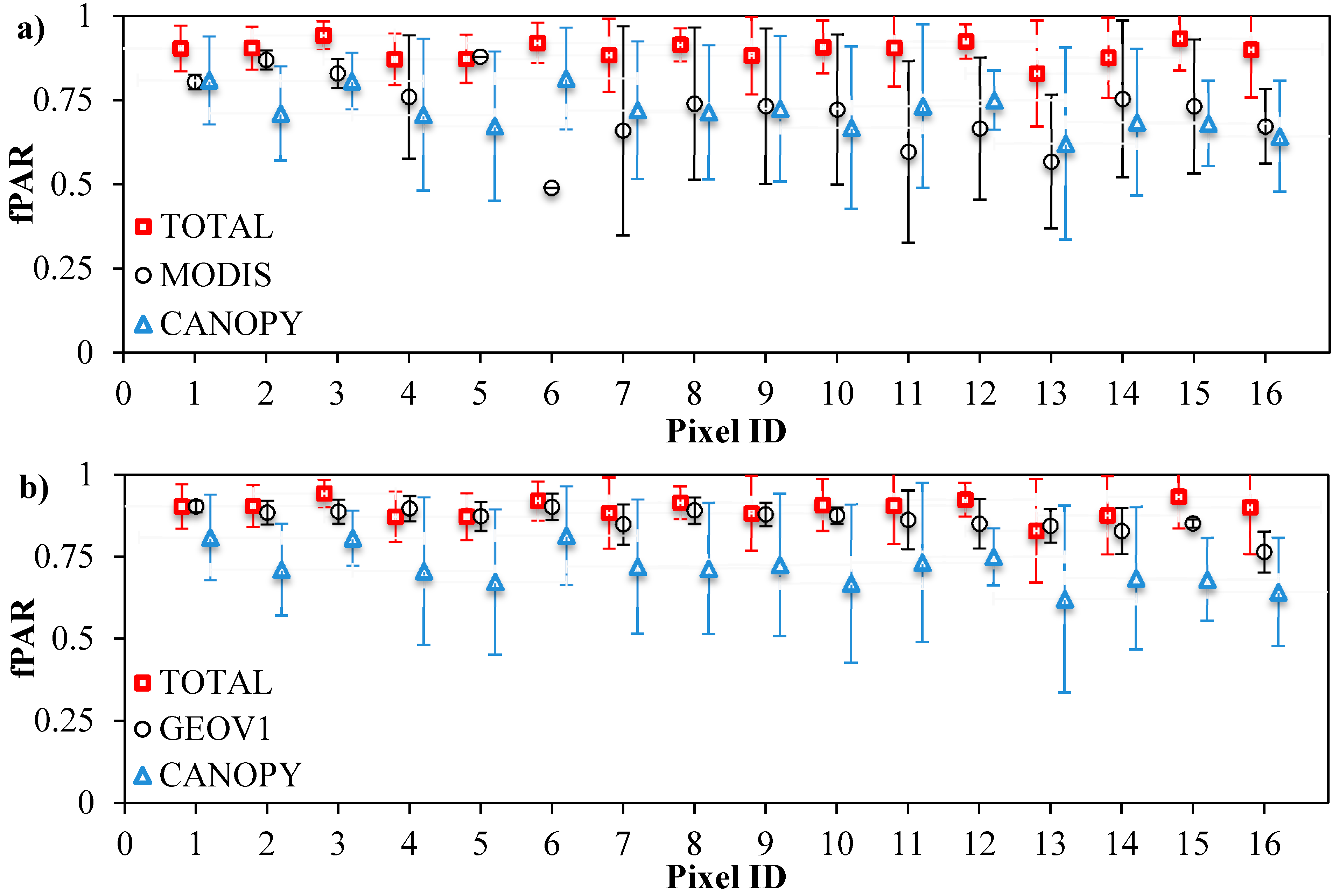
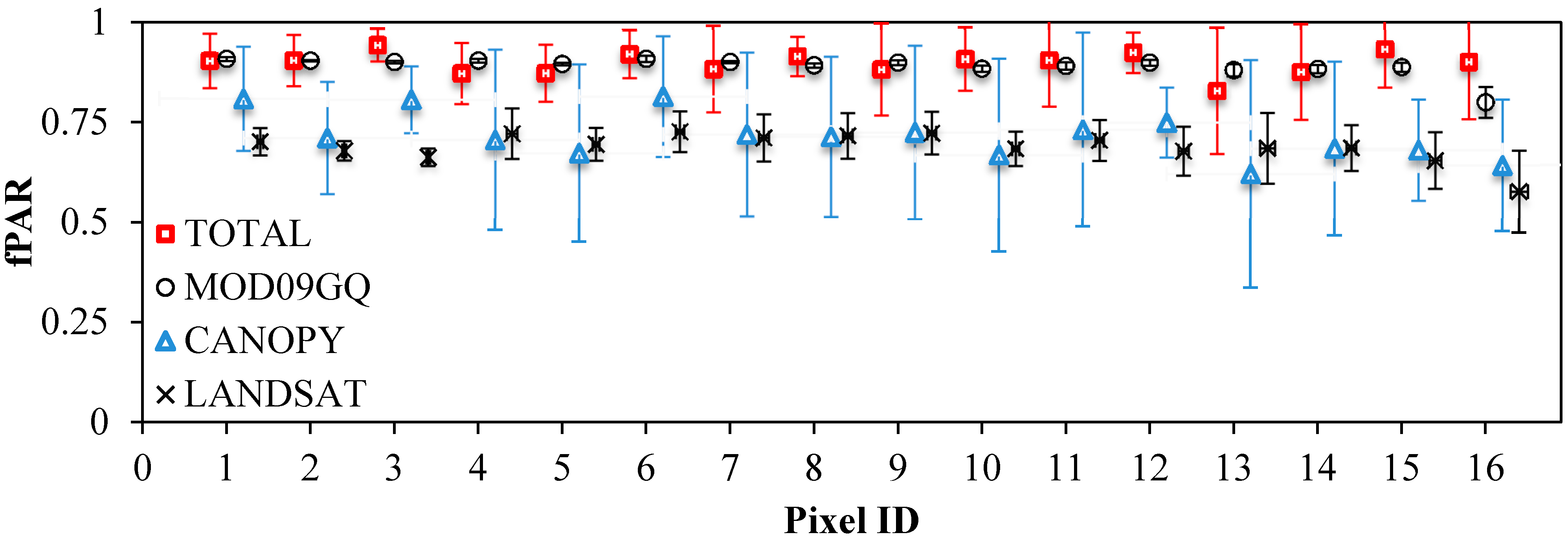
4. Discussion
5. Conclusions
Acknowledgments
Author Contributions
Conflicts of Interest
References
- Global Climate Observing System (GCOS). Update on Progress Made by Space Agencies Involved in Global Observations in Their Coordinated Response to Relevant Needs of the Global Climate Observing System and the Convention. Available online: http://www.wmo.int/pages/prog/gcos/documents/SBSTA37_misc14_CEOS.pdf (accessed on 3 December 2014).
- Monteith, J.L. Solar radiation and productivity in tropical ecosystems. J. Appl. Ecol. 1972, 9, 747–766. [Google Scholar] [CrossRef]
- Rouse, J.W.; Haas, R.H.; Schell, J.A.; Deering, D.W. Monitoring vegetation systems in the Great Plains with ERTS. Technical Presentations. In Third Earth Resources Technology Satellite-1 Symposium; NASA SP-351. NASA: Washington, DC, USA, 1974; pp. 309–317. [Google Scholar]
- McCallum, I.; Wagner, W.; Schmullius, C.; Shvidenko, A.; Obersteiner, M.; Fritz, S.; Nilsson, S. Comparison of four global FAPAR datasets over Northern Eurasia for the year 2000. Remote Sens. Environ. 2010, 114, 941–949. [Google Scholar]
- D’Odorico, P.; Gonsamo, A.; Pinty, B.; Gobron, N.; Coops, N.; Mendez, E.; Schaepman, M.E. Intercomparison of fraction of absorbed photosynthetically active radiation products derived from satellite data over Europe. Remote Sens. Environ. 2014, 142, 141–154. [Google Scholar] [CrossRef]
- Pickett-Heaps, C.; Canadell, J.; Briggs, P.; Gobron, N.; Haverd, V.; Paget, M.; Pinty, B.; Raupach, M. Evaluation of six satellite-derived Fraction of Absorbed Photosynthetic Active Radiation (FAPAR) products across the Australian continent. Remote Sens. Environ. 2014, 140, 241–256. [Google Scholar] [CrossRef]
- Olofsson, P.; Eklundh, L. Estimation of absorbed PAR across Scandinavia from satellite measurements. Part II: Modeling and evaluating the fractional absorption. Remote Sens. Environ. 2007, 110, 240–251. [Google Scholar]
- Steinberg, D.C.; Goetz, S.J.; Hyer, E.J. Validation of MODIS FPAR products in boreal forests of Alaska. IEEE Trans. Geosci. Remote Sens. 2006, 44, 1818–1828. [Google Scholar] [CrossRef]
- Iwata, H.; Ueyama, M.; Iwama, C.; Harazono, Y. A variation in the fraction of absorbed photosynthetically active radiation and a comparison with MODIS data in burned black spruce forests of interior Alaska. Polar Sci. 2013, 7, 113–124. [Google Scholar] [CrossRef]
- Martínez, B.; Camacho, F.; Verger, A.; García-Haro, F.J.; Gilabert, M.A. Intercomparison and quality assessment of MERIS, MODIS and SEVIRI FAPAR products over the Iberian Peninsula. Int. J. Appl. Earth Obs. Geoinf. 2013, 21, 463–476. [Google Scholar] [CrossRef]
- Steinberg, D.C.; Goetz, S.J. Assessment and extension of the MODIS FPAR products in temperate forests of the eastern United States. Int. J. Remote Sens. 2009, 30, 169–187. [Google Scholar] [CrossRef]
- Senna, M.C.; Costa, M.H.; Shimabukuro, Y.E. Fraction of photosynthetically active radiation absorbed by Amazon tropical forest: A comparison of field measurements, modeling, and remote sensing. J. Geophys. Res. 2005, 110. [Google Scholar] [CrossRef]
- Weiss, M.; Baret, F.; Block, T.; Koetz, B.; Burini, A.; Scholze, B.; Lecharpentier, P.; Brockmann, C.; Fernandes, R.; Plummer, S.; et al. On Line Validation Exercise (OLIVE): A web based service for the validation of medium resolution land products. Application to FAPAR products. Remote Sens. 2014, 6, 4190–4216. [Google Scholar]
- Camacho, F.; Cernicharo, J.; Lacaze, R.; Baret, F.; Weiss, M. GEOV1: LAI, FAPAR essential climate variables and FCOVER global time series capitalizing over existing products. Part 2: Validation and intercomparison with reference products. Remote Sens. Environ. 2013, 137, 310–329. [Google Scholar]
- Serbin, S.P.; Ahl, D.E.; Gower, S.T. Spatial and temporal validation of the MODIS LAI and fPAR products across a boreal forest wildfire chronosequence. Remote Sens. Environ. 2013, 133, 71–84. [Google Scholar] [CrossRef]
- Combal, B.; Baret, F.; Weiss, M.; Trubuil, A.; Mace, D.; Pragnere, A.; Myneni, R.; Knyazikhin, Y.; Wang, L. Retrieval of canopy biophysical variables from bidirectional reflectance using prior information to solve the ill-posed inverse problem. Remote Sens. Environ. 2003, 84, 1–15. [Google Scholar] [CrossRef]
- Gobron, N.; Pinty, B.; Aussedat, O.; Taberner, M.; Faber, O.; Mélin, F.; Levergne, T.; Robustelli, M.; Snoeij, P. Uncertainty estimates for the FAPAR operational products derived from MERIS—Impact of top-of-atmosphere radiance uncertainties and validation with field data. Remote Sens. Environ. 2008, 112, 1871–1883. [Google Scholar] [CrossRef]
- Mõttus, M.; Sulev, M.; Baret, F.; Lopez-Lozano, R.; Reinart, A. Photosynthetically active radiation: Measurement and modeling. In Encyclopedia of Sustainability Science and Technology; Meyers, R., Ed.; Springer: New York, NY, USA, 2012; pp. 7900–7932. [Google Scholar]
- Stenberg, P.; Lukeš, P.; Rautiainen, M.; Manninen, M. A new approach for simulating forest albedo based on spectral invariants. Remote Sens. Environ. 2013, 137, 12–16. [Google Scholar] [CrossRef]
- Majasalmi, T.; Rautiainen, M.; Stenberg, P. Modeled and measured fPAR in a boreal forest: Validation and application of a new model. Agr. Forest Meteorol. 2014, 189–190, 118–124. [Google Scholar]
- CORINE Land Cover 2006. Coordination of Information on the Environment. Available online: http://www.eea.europa.eu/publications/COR0-landcover (accessed on 3 December 2014).
- Fang, H.; Li, W.; Myneni, R.B. The impact of potential land cover misclassification on MODIS leaf area index (LAI) estimation: A statistical perspective. Remote Sens. 2013, 5, 830–844. [Google Scholar] [CrossRef]
- Rautiainen, M.; Mōttus, M.; Heiskanen, J.; Akujärvi, A.; Majasalmi, T.; Stenberg, P. Seasonal reflectance dynamics of common understory types in a northern European boreal forest. Remote Sens. Environ. 2011, 115, 3020–3028. [Google Scholar] [CrossRef]
- LI-COR. LAI-2000 Plant Canopy Analyzer: Instruction Manual. Available online: ftp://ftp.licor.com/perm/env/LAI-2000/Manual/LAI-2000_Manual.pdf (accessed on 3 December 2014).
- Leblanc, S.G.; Chen, J.M.; Kwong, M. Tracing Radiation and Architecture of Canopies. TRAC Manual. Version 2.1.3. Available online: http://faculty.geog.utoronto.ca/Chen/Chen’s%20homepage/PDFfiles/tracmanu.pdf (accessed on 3 December 2014).
- VALERI. Validation of Land European Remote Sensing Instruments. Available online: http://w3.avignon.inra.fr/valeri/ (accessed on 3 December 2014).
- Majasalmi, T.; Rautiainen, M.; Stenberg, P.; Rita, H. Optimizing sampling scheme for LAI-2000 measurements in a boreal forest. Agr. Forest Meteorol. 2012, 154–155, 38–43. [Google Scholar]
- Smolander, S.; Stenberg, P. Simple parameterizations of the radiation budget of uniform broadleaved and coniferous canopies. Remote Sens. Environ. 2005, 94, 355–363. [Google Scholar] [CrossRef]
- Stenberg, P. Simple analytical formula for calculating average photon recollision probability in vegetation canopies. Remote Sens. Environ. 2007, 109, 221–224. [Google Scholar] [CrossRef]
- Smolander, S.; Stenberg, P.; Linder, S. Dependence of light interception efficiency of Scots pine shoots on structural parameters. Tree Physiol. 1994, 14, 971–980. [Google Scholar] [CrossRef] [PubMed]
- Stenberg, P.; Linder, S.; Smolander, H. Variation in the ratio of shoot silhouette area to needle area in fertilized and nonfertilized Norway spruce trees. Tree Physiol. 1995, 15, 705–712. [Google Scholar] [CrossRef] [PubMed]
- Lukeš, P.; Stenberg, P.; Rautiainen, M.; Mõttus, M.; Vanhatalo, K.M. Optical properties of leaves and needles for boreal tree species in Europe. Remote Sens. Lett. 2013, 4, 667–676. [Google Scholar] [CrossRef]
- Knyazikhin, Y.; Glassy, J.; Privette, J.L.; Tian, Y.; Lotsch, A.; Zhang, Y.; Wang, Y.; Morisette, J.T.; Votava, P.; Myneni, R.B.; et al. MODIS Leaf Area Index (LAI) and Fraction of Photosynthetically Active Radiation Absorbed by Vegetation (FPAR) Product (MOD15) Algorithm, Theoretical Basis Document. Available online: http://modis.gsfc.nasa.gov/data/atbd/atbd_mod15.pdf (accessed on 3 December 2014).
- Myneni, R.B.; Hoffman, S.; Knyazikhin, Y.; Privette, J.L.; Glassy, J.; Tian, Y.; Wang, Y.; Song, X.; Zhang, Y.; Smith, G.R.; et al. Global products of vegetation leaf area and fraction absorbed PAR from year one of MODIS data. Remote Sens. Environ. 2002, 83, 214–231. [Google Scholar]
- Baret, F.; Weiss, M.; Lacaze, R.; Camacho, F.; Makhmara, H.; Pacholcyzk, P.; Smets, B. GEOV1: LAI and FAPAR essential climate variables and FCOVER global time series capitalizing over existing products. Part1: Principles of development and production. Remote Sens. Environ. 2013, 137, 299–309. [Google Scholar] [CrossRef]
- MetINFO Phenological Observations. Available online: http://www.metla.fi/metinfo/fenologia/index-en.htm (accessed on 3 December 2014).
- Chen, J. Evaluation of vegetation indices and a modified simple ratio for boreal applications. Can. J. Remote Sens. 1996, 22, 229–242. [Google Scholar] [CrossRef]
- CEOS Cal/Val Portal. Available online: http://calvalportal.ceos.org/web/olive (accessed on 3 December 2014).
- Stenberg, P.; Rautiainen, M.; Manninen, T.; Voipio, P.; Smolander, H. Reduced simple ratio better than NDVI for estimating LAI in Finnish pine and spruce stands. Silva Fenn. 2004, 38, 3–14. [Google Scholar] [CrossRef]
- Pisek, J.; Rautiainen, M.; Heiskanen, J.; Mõttus, M. Retrieval of seasonal dynamics of forest understory reflectance in a Northern European boreal forest from MODIS BRDF data. Remote Sens. Environ. 2012, 117, 464–468. [Google Scholar] [CrossRef]
- Eenmäe, A.; Nilson, T.; Lang, M. A note on meteorological variables related trends in the MODIS NPP product for Estonia. Forest. Stud. 2011, 55, 60–63. [Google Scholar]
- Ganguly, S.; Nemani, R.R.; Zhang, G.; Hashimoto, H.; Milesi, C.; Michaelis, A.; Wang, W.; Votava, P.; Samanta, A.; Melton, F.; et al. Generating global leaf area index from Landsat: Algorithm formulation and demonstration. Remote Sens. Environ. 2012, 122, 185–202. [Google Scholar]
© 2015 by the authors; licensee MDPI, Basel, Switzerland. This article is an open access article distributed under the terms and conditions of the Creative Commons Attribution license (http://creativecommons.org/licenses/by/4.0/).
Share and Cite
Majasalmi, T.; Rautiainen, M.; Stenberg, P.; Manninen, T. Validation of MODIS and GEOV1 fPAR Products in a Boreal Forest Site in Finland. Remote Sens. 2015, 7, 1359-1379. https://doi.org/10.3390/rs70201359
Majasalmi T, Rautiainen M, Stenberg P, Manninen T. Validation of MODIS and GEOV1 fPAR Products in a Boreal Forest Site in Finland. Remote Sensing. 2015; 7(2):1359-1379. https://doi.org/10.3390/rs70201359
Chicago/Turabian StyleMajasalmi, Titta, Miina Rautiainen, Pauline Stenberg, and Terhikki Manninen. 2015. "Validation of MODIS and GEOV1 fPAR Products in a Boreal Forest Site in Finland" Remote Sensing 7, no. 2: 1359-1379. https://doi.org/10.3390/rs70201359
APA StyleMajasalmi, T., Rautiainen, M., Stenberg, P., & Manninen, T. (2015). Validation of MODIS and GEOV1 fPAR Products in a Boreal Forest Site in Finland. Remote Sensing, 7(2), 1359-1379. https://doi.org/10.3390/rs70201359





